The Different Ways Milk Is Sold Around The World And Why
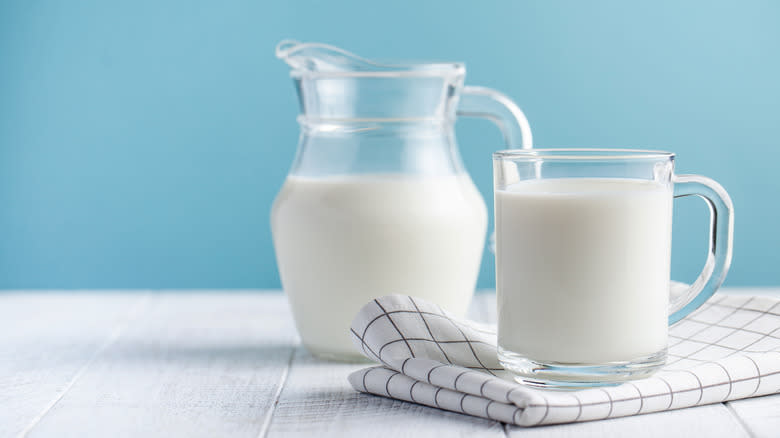
Human beings have been drinking milk for thousands of years, probably starting somewhere around 5,000 BC. That's a lot of time to get creative with this nutrient-dense "food of the gods," as the ancients used to say. Did you know that ancient Russians used to throw a single frog into their barrels of milk to preserve it? And would you believe that modern science has proven that it works?
We have better methods of preservation these days than frogs, but in general, there remains a huge variety of ways that milk is sold all around the world. Keep in mind that just because a particular type of milk is popular in one given area, that doesn't mean that it's the only way milk is available there. Highly pasteurized milk may be the most popular choice in a particular region, but milk powder is probably still somewhere in the grocery store. The stories of why one form of milk came to dominate the grocery industry make for interesting history, especially when you compare it to other regions.
Read more: 25 Most Popular Snacks In America Ranked Worst To Best
The United States Prefers Pasteurized

Americans prefer pasteurized milk by a pretty wide margin. You can recognize pasteurized milk because it's kept in the refrigerator at the grocery store and needs to be refrigerated while being transported as well. Pasteurized milk is also often homogenized, which is the process whereby the fat molecules are broken up so that they don't rise to the top and form a layer of cream. This keeps the milk the same texture throughout.
Pasteurization is a fairly well-known concept, but for those of you scratching your brain trying to remember what your high school science teacher said, it's the process whereby bacteria is killed to prolong the shelf life of a food product. For milk, that means it gets heated to anywhere from 145 to 250 degrees Fahrenheit and kept there for a specified amount of time. Typically, American dairy companies will heat the milk to 161 degrees and hold it there for 15 seconds. Small dairy farms will often heat the milk to 145 degrees and keep it there for 30 minutes, a process known as low-temperature pasteurization.
Europe Prefers Aseptic Milk
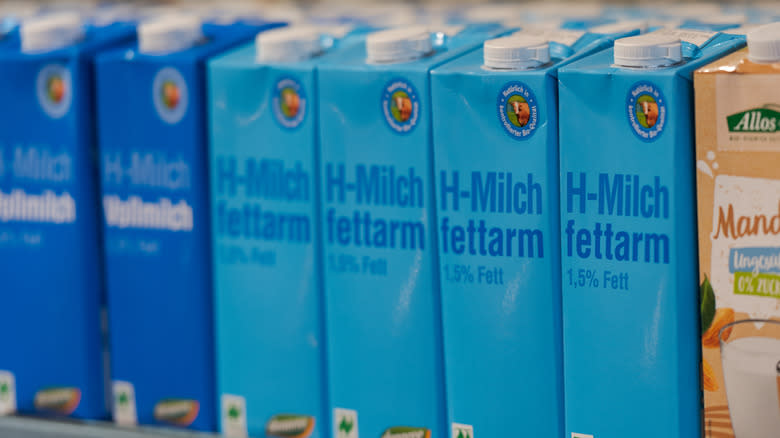
If you're in Europe, you'll notice that their dairy is kept on the shelf unrefrigerated. This shelf-stable milk can be a bit jarring for anyone who's been conditioned to believe that unrefrigerated milk is dangerous, but it's perfectly safe. European dairy companies are able to achieve this through what's known as ultra-high temperature (UHT) pasteurization, which heats the milk to 280 degrees Fahrenheit for two seconds. The temperature and time may change somewhat depending on the dairy producer since regulators take the equipment being used into consideration. Milk that has gone through UHT pasteurization is known as aseptic milk.
Aseptic milk has the great benefit of being less energy-demanding since it doesn't need to be refrigerated, which is good for the climate and often easier on the wallet. Aseptic milk can sit in your pantry for several months before going bad, though it needs to be refrigerated once opened and used within a week. Though there is debate over the nutritional difference between pasteurized and aseptic milk, it appears that this confusion is unfounded. There's no nutritional difference between the two, only a difference in how they are pasteurized.
Canada Is The Land Of Bagged Milk
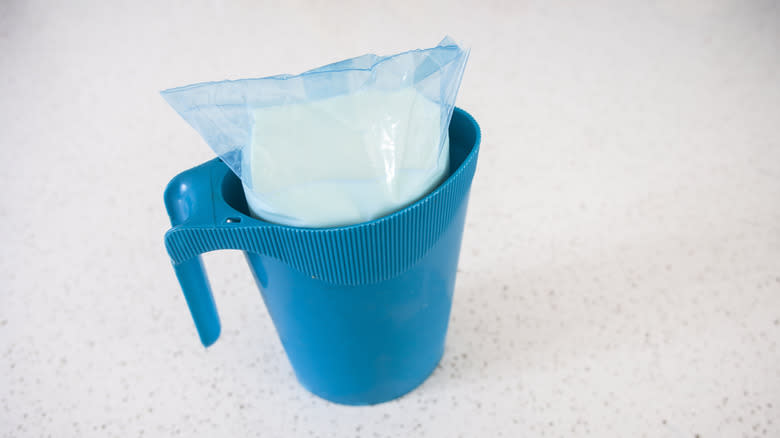
Shopping for milk in Eastern Canada may give you a bit of a shock since it's typically sold in big plastic bags. Regulations are changing, and hard plastic jugs are becoming more popular as they do, but plastic bags still reign supreme in areas like Ontario and Quebec. The bags don't reseal, in case you were wondering. Everyone has a plastic bag holder at home that looks like a pitcher. They set the bag in the holder and snip off a corner with some scissors. When they're ready to use it, they simply pour it out of the hole they cut.
For anyone wondering why Canadians would go through all this trouble, the reason comes down to the good old metric system. Before the plastic bag idea came around, milk was sold in expensive glass bottles. Plastic bags came onto the Canadian market in 1967, and Canada switched to the metric system shortly after in the 1970s. Hard plastic jugs hadn't been invented yet, and all of the milk containers used at the time were in imperial units. Plastic bags were the easiest and cheapest containers to adjust the size of, so they came to dominate the market. That, combined with regulations around dairy retailers needing to provide recycling options for all milk containers except for plastic bags, and it simply became more economical to use the bags. Although they originated in Canada, plastic milk bags can also be found in Russia, South Africa, Israel, Argentina, Uruguay, Iran, Hungary, and China.
India Still Has Daily Milk Delivery
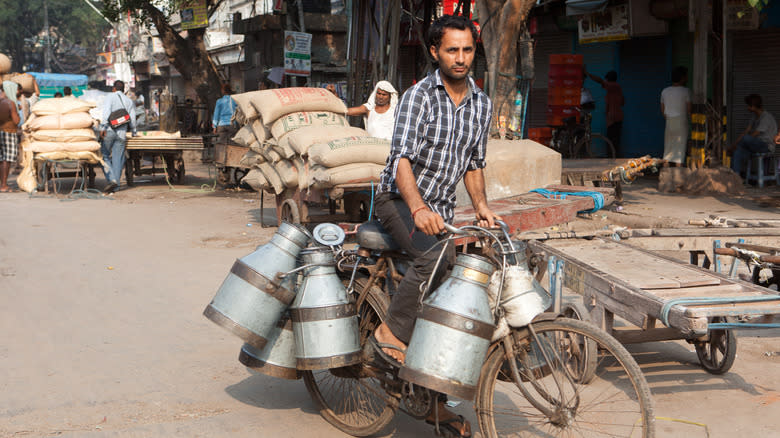
India is the world's biggest producer of milk, contributing 22% of the world's dairy production, though the United States seems primed to overtake them. Roughly 85% of that milk is produced by small farms with less than ten cattle, much of which is still delivered daily to rural homes. The milk is commonly boiled before consumption to reduce the risk of illness, though there are dairy startups looking to change that, like Milky Moo, whose motto is "no need to boil."
Much like other countries, India turned away from its previous use of heavy glass bottles in the 1980s in favor of cheaper alternatives like plastic. However, modern Indian milk brands have since brought back the glass bottle as a marketing tactic for health-conscious consumers with a bigger food budget. In heavily urbanized areas, where door-to-door delivery is less practical, there are now vending machines that keep the milk chilled in one centralized location for customers to use. Milk delivery companies have been operating with thin margins, and as the price of Indian milk continues to climb, that margin is straining their ability to compete.
Asia Is Switching To Milk Powder
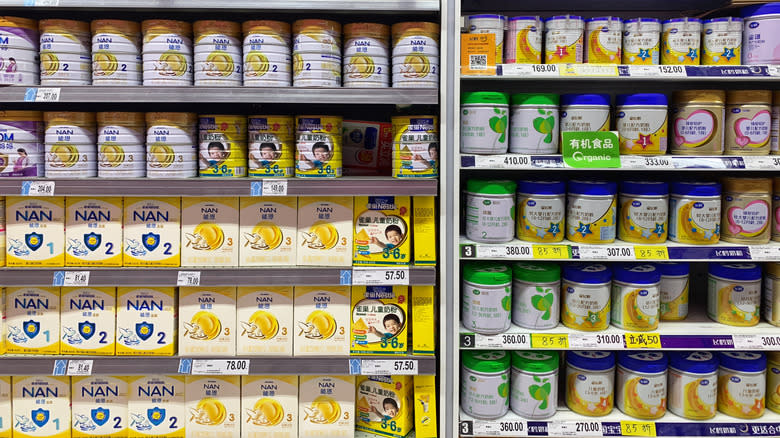
Milk powder is exactly what it sounds like; it's milk that's had all of the liquid pulled out of it. It can be found globally, but the Asia-Pacific is the fastest-growing market, and the trend shows no signs of slowing. Prices vary considerably across the globe, but milk powder's proponents tout its long shelf life and ease of transport as being the reasons why developing nations, in particular, are increasingly turning to this fresh milk alternative.
Although powdered milk was invented in the first half of the 19th century, it wasn't until 1868 that it became commercially viable. Milk is first pasteurized and then dehydrated to prevent any bacteria from surviving, even in powder form. This combination makes milk powder an effective kitchen staple for regions that don't have regular access to fresh milk and a popular choice for anyone stockpiling food in the event of a natural disaster or other crisis. Milk powder is also a common ingredient in baked goods. Powdered milk has the same nutritional value as fresh milk, making it an excellent source of calcium, protein, and vitamins A and D. Regulation requires powdered milk to have a best-by date of around two years. Still, it's shelf-stable enough to last much, much longer if stored properly. Powdered milk is also quite popular in Europe, though it can be found globally.
Read the original article on Tasting Table.


